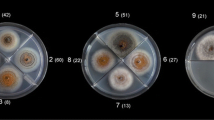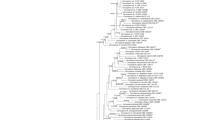Abstract
Twenty-three isolates of Colletotrichum gloeosporioides, five isolates of C. acutatum, two isolates of C. capsici and six isolates of C. boninense associated with anthracnose disease on coffee (Coffea spp.) in Vietnam were identified based on morphology and DNA analysis. Phylogenetic analysis of DNA sequences from the internal transcribed spacer region of nuclear rDNA and a portion of mitochondrial small subunit rRNA were concordant and allowed good separation of the taxa. We found several Colletotrichum isolates of unknown species and their taxonomic position remains unresolved. The majority of Vietnamese isolates belonged to C. gloeosporioides and they grouped together with the coffee berry disease (CBD) fungus, C. kahawae. However, C. kahawae could be distinguished from the Vietnamese C. gloeosporioides isolates based on ammonium tartrate utilization, growth rate and pathogenicity. C. gloeosporioides isolates were more pathogenic on detached green berries than isolates of the other species, i.e. C. acutatum, C capsici and C. boninense. Some of the C. gloeosporioides isolates produced slightly sunken lesions on green berries resembling CBD symptoms but it did not destroy the bean. We did not find any evidence of the presence of C. kahawae in Vietnam.




Similar content being viewed by others
References
Abang, M. M., Asiedu, R., Hoffmann, P., Wolf, G. A., Mignouna, H. D., & Winter, S. (2006). Pathogenic and genetic variability among Colletotrichum gloeosporioides isolates from different yam hosts in the agroecological zones in Nigeria. Journal of Phytopathology, 154, 51–61.
Bock, K. R. (1956). Investigations on coffee berry disease-laboratory studies. East African Agricultural and Forestry Journal, 22, 97–103.
Bridge, P. D., Waller, J. M., Davies, D., & Buddie, A. G. (2008). Variability of Colletotrichum kahawae in relation to other Colletotrichum species from tropical perennial crops and the development of diagnostic techniques. Journal of Phytopathology, 156, 274–280.
Cannon, P. F., Buddie, A. G., & Bridge, P. D. (2008). The typification of Colletotrichum gloeosporioides. Mycotaxon, 104, 189–204.
Chen, Z. J., Ribeiro, A., Silva, M. C., et al. (2003). Heat shock-induced susceptibility of green coffee leaves and berries to Colletotrichum gloeosporioides and its association to PR and hsp70 gene expression. Physiological and Molecular Plant Pathology, 63, 181–190.
Chen, Z. J., Liang, J., & Rodrigues, C. J. J. (2005). Colletotrichum gloeosporioides can overgrow Colletotrichum kahawae on green coffee berries first inoculated with C. kahawae. Biotechnology Letters, 27, 679–682.
Derso, E., & Waller, J. M. (2003). Variation among Colletotrichum isolates from diseased coffee berries in Ethiopia. Crop Protection, 22, 561–565.
Ewing, B., & Green, P. (1998). Base-calling of automated sequencer traces using phred. II. Error probabilities. Genome Research, 8, 186–194.
Farr, D. F., Aime, M. C., Rossman, A. Y., & Palm, M. E. (2006). Species of Colletotrichum on agavaceae. Mycological Research, 110, 1395–1408.
Freeman, S. (2000). Genetic diversity and host specificity of Colletotrichum species on various fruits. In D. Prusky, S. Freeman & M. B. Dickman (Eds.), Colletotrichum: Host specificity, pathology, and host-pathogen interaction (pp. 131–144). St Paul: APS.
Gielink, A., & Vermeulen, H. (1983). The ability of American and African Colletotrichum isolates to cause coffee berry disease symptoms and the association of some isolates with Glomerella cingulata. European Journal of Plant Pathology, 89, 188–190.
Kenny, M. K., Galea, V. J., Scott, P. T., & Price, T. V. (2006). A comparison of Colletotrichum species associated with berry diseases of Coffea arabica L. Pest and disease incursion: risk, threats and management in Papua New Guinea.ACIAR Technical Reports, 62, 192–199.
Li, K. N., Rouse, D. I., & German, T. L. (1994). PCR primers that allow intergeneric differentiation of ascomycetes and their application to Verticillium spp. Applied and Environmental Microbiology, 60, 4324–4331.
Lu, G., Cannon, P. F., Reid, A., & Simmons, C. M. (2004). Diversity and molecular relationships of endophytic Colletotrichum isolates from the Iwokrama Forest Reserve, Guyana. Mycological Research, 108, 53–63.
Lubbe, C. M., Denman, S., Cannon, P. F., Groenewald, J. Z., Lamprecht, S. C., & Crous, P. W. (2004). Characterization of Colletotrichum species associated with diseases of Proteaceae. Mycologia, 96, 1268–1279.
Martinez-Culebras, P. V., Querol, A., Suarez-Fernandez, M. B., Garcia-Lopez, M. D., & Barrio, E. (2003). Phylogenetic relationships among Colletotrichum pathogens of strawberry and design of PCR primers for their identification. Journal of Phytopathology, 151, 135–143.
Masaba, D. M., & Waller, J. M. (1992). Coffee berry disease: The current status. In J. A. Bailey & M. J. Jeger (Eds.), Colletotrichum: Biology, pathology and control (pp. 237–249). Wallingford: CAB International.
Mills, P. R., Hodson, A., & Brown, A. E. (1992). Molecular differentiation of Colletotrichum gloeosporioides isolates infecting tropical fruits. In J. A. Bailey & M. J. Jeger (Eds.), Colletotrichum: Biology, pathology and control (pp. 269–288). Wallingford: CAB International.
Mordue, J. E. M. (1971). CMI descriptions of pathogenic fungi and bacteria. Kew: Commonwealth Mycological Institute.
Moriwaki, J., Sato, T., & Tsukiboshi, T. (2003). Morphological and molecular characterization of Colletotrichum boninense sp. nov. from Japan. Mycoscience, 44, 47–53.
Nguyen, T. H. P., Säll, T., Bryngelsson, T., & Liljeroth, E. (2009). Variation among Colletotrichum gloeosporioides isolates from infected coffee berries at different locations in Vietnam. Plant Pathology, 58, 898–909.
Photita, W., Taylor, P. W. J., Ford, R., Hyde, K. D., & Lumyong, S. (2005). Morphological and molecular characterization of Colletotrichum species from herbaceous plants in Thailand. Fungal Diversity, 18, 117–133.
Pinkert, C. (2004). Nutrient & quality analysis of coffee cherries in Huong Hoa district, Vietnam. Wageningen: Plant research International BV.
Shenoy, B. D., Jeewon, R., Lam, W. H., et al. (2007). Morpho-molecular characterisation and epitypification of Colletotrichum capsici (Glomerellaceae, Sordariomycetes), the causative agent of anthracnose in chilli. Fungal Diversity, 27, 197–211.
Smith, B. J., & Black, L. L. (1990). Morphological, cultural, and pathogenic variation among Colletotrichum species isolated from strawberry. Plant Disease, 74, 69–76.
Sreenivasaprasad, S., Brown, A. E., & Mills, P. R. (1992). DNA sequence variation and interrelationships among Colletotrichum species causing strawberry anthracnose. Physiological and Molecular Plant Pathology, 41, 265–281.
Sreenivasaprasad, S., Brown, A. E., & Mills, P. R. (1993). Coffee berry disease pathogen in Africa: genetic structure and relationship to the group species Colletotrichum gloeosporioides. Mycological Research, 97, 995–1000.
Sreenivasaprasad, S., Mills, P. R., Meehan, B. M., & Brown, A. E. (1996a). Phylogeny and systematics of 18 Colletotrichum species based on ribosomal DNA spacer sequences. Genome, 39, 499–512.
Sreenivasaprasad, S., Sharada, K., Brown, A. E., & Mills, P. R. (1996b). PCR-based detection of Colletotrichum acutatum on strawberry. Plant Pathology, 45, 650.
Sutton, B. C. (1980). The coelomycetes. Fungi imperfecti with pycnidia, acervuli and stromata. Kew: Commonwealth Mycological Institute.
Sutton, B. C. (1992). The genus Glomerella and its anamorph Colletotrichum. In J. A. Bailey & M. J. Jeger (Eds.), Colletotrichum: Biology, pathology and control (pp. 1–26). Wallingford: CAB International.
Talhinhas, P., Sreenivasaprasad, S., Neves-Martins, J., & Oliveira, H. (2005). Molecular and phenotypic analyses reveal association of diverse Colletotrichum acutatum groups and a low level of Colletotrichum gloeosporioides with olive anthracnose. Applied and Environmental Microbiology, 71, 2987–2998.
Than, P. P., Jeewon, R., Hyde, K. D., Pongsupasamit, S., Mongkolporn, O., & Taylor, P. W. J. (2008). Characterization and pathogenicity of Colletotrichum species associated with anthracnose on chilli (Capsicum spp.) in Thailand. Plant Pathology, 57, 562–572.
Tozze, H. J., Massola, N. M., Camara, M. P. S., et al. (2009). First report of Colletotrichum boninense causing anthracnose on pepper in Brazil. Plant Disease, 93, 106.
Tran, K. L., Vu, T. T. N., & Ngo, T. X. T. (1998). Results of investigation of coffee berry disease and die-back on Arabica coffee var. Catimor. Monthly Journal of Science, Technology and Economic Management (in Vietnamese), 6, 253–255.
Ureña-Padilla, A. R., Mackenzie, S. J., Bowen, B. W., & Legard, D. E. (2002). Etiology and population genetics of Colletotrichum spp. causing crown and fruit rot of strawberry. Phytopathology, 92, 1245–1252.
Varzea, V. M., Rodrigues, C. J., Jr., & Lewis, B. G. (2002). Distinguishing characteristics and vegetative compatibility of Colletotrichum kahawe in comparison with other related species from coffee. Plant Pathology, 51, 202.
Vinnere, O., Fatehi, J., Wright, S. A. I., & Gerhardson, B. (2002). The causal agent of anthracnose of Rhododendron in Sweden and Latvia. Mycological Research, 106, 60–69.
Von Arx, J. A. (1957). Die arten der Gattung Colletotrichum cda. Phytopathologische Zeitschrift, 29, 413–468.
Waller, J. M. (1992). Colletotrichum diseases of perennial and other cash crops. In J. A. Bailey & M. J. Jeger (Eds.), Colletotrichum: Biology, pathology and control (pp. 131–142). Wallingford: CAB International.
Waller, J. M., Bridge, P. D., Black, B., & Hakiza, G. (1993). Characterization of the coffee berry disease pathogen Colletotrichum kahawae sp. nov. Mycological Research, 97, 989–994.
White, T., Bruns, T., Lee, S., & Taylor, J. (1990). Amplification and direct sequencing of fungal ribosomal RNA genes for phylogenetics. PCR Protocols: A Guide to Methods and Applications, 18, 315–322.
Zar, J. (1984). Biostatistical analysis. Englewood Cliffs: Prentice-Hall.
Acknowledgements
The authors acknowledge the Swedish International Development Agency (Sida) for financial support. We are thankful to Dr Sreenivasaprasad for kindly supplying isolates NI 90, 397 and PR220 used in this study. We also thank Ms Therese Bengtsson, Hoang Thi Ngat and Ann-Charlotte Strömdahl for excellent technical assistances. We acknowledge Mrs. Tran Kim Loang, Bui Thi Tram, Nguyen Thanh Ha, Mr Nguyen Cong Huyen, Le Quang Tu and coworkers in Dac Lak and Lam Dong province for valuable field trip arrangements and assistance during field samplings.
Author information
Authors and Affiliations
Corresponding author
Rights and permissions
About this article
Cite this article
Nguyen, P.T.H., Vinnere Pettersson, O., Olsson, P. et al. Identification of Colletotrichum species associated with anthracnose disease of coffee in Vietnam. Eur J Plant Pathol 127, 73–87 (2010). https://doi.org/10.1007/s10658-009-9573-5
Accepted:
Published:
Issue Date:
DOI: https://doi.org/10.1007/s10658-009-9573-5




